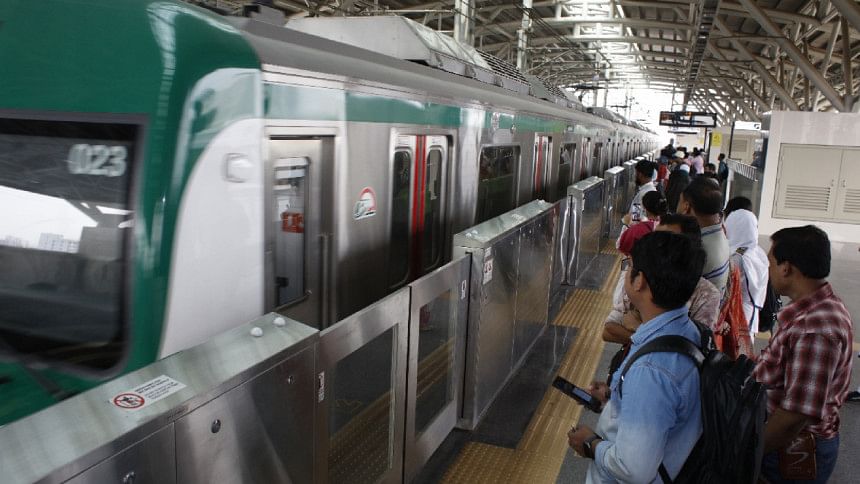How will MRT6 shape Dhaka's future?

Dhaka, the bustling capital of Bangladesh, has long grappled with the chaos of congested streets, rendering it one of the most challenging cities in the world to navigate. In response to this challenge, MRT6 has emerged as a significant development, potentially transforming the city's commuting landscape. Let's delve into the multifaceted impact of MRT6 on Dhaka's economic, social, and environmental landscape.
Improved Connectivity
The notion of traveling 21.6 kilometers in just 40 minutes was once beyond imagination for Dhaka's residents. However, MRT6 has transformed this vision of swift and efficient transportation into reality. The capital city has already savored the benefits of a rapid transportation system with the inauguration of MRT6's initial phase from Uttara to Agargaon in December of the preceding year.
With the capacity to transport approximately 60 thousand people per hour, MRT6 stands to serve around 0.7 million passengers each day. Amreen Chowdhury, a 27-year-old young professional who had to abandon her job due to the arduous 4-hour commute from Uttara to Motijhil, views this as a significant milestone for Bangladesh, contributing to an improved standard of living and economic prospects.
Amreen's sentiments resonate with those of countless others as she remarks, "It is not only about reducing travel time but also about enhancing productivity by alleviating the numerous challenges associated with reaching any destination in Dhaka, considering the disproportionate ratio between population density and available transport systems, along with inadequate road infrastructure."
Farmgate, recognized as an area with the highest volume of commuters in Dhaka city, would potentially benefit from a new station, offering an alternative transportation solution that eases the strain on existing public transport services. This, in turn, promises relief both in terms of physical congestion and the psychological toll of traffic.
However, experts stress the need for careful station planning to manage passenger flow and provide various transportation options effectively. They also highlight concerns about financial sustainability, calling for proper land use controls, regulations, and multimodal connectivity to prevent unintentional centralization in Dhaka due to haphazard urban development along the MRT routes.
Economic Impact
Viewing the financial landscape, MRT6 is projected to save BDT 8.38 crore in daily travel time costs and BDT 1.18 crore in vehicle operational expenses, culminating in annual savings of 3,489.40 crore.
The introduction of the metro rail system has also triggered transformations in land use along the MRT routes, leading to significant development, particularly in underdeveloped areas such as Uttara and Mirpur. This development has generated numerous job opportunities, breathed new life into local businesses, expanded economic activities, and stimulated the housing market. Improved connectivity has attracted fresh investments while reducing travel times, yielding positive economic outcomes.
On November 4, the MRT6 is set to inaugurate its second phase, which extends from Uttara to Motijhil, encompassing crucial intermediate stops, including Farmgate, Karwan Bazar, Shahbagh, TSC, and the Press Club.
Motijhil, once a thriving business hub, witnessed a decline in its appeal, primarily due to factors like persistent traffic congestion. However, urban experts anticipate that the expansion of MRT6 to Motijhil could potentially rejuvenate its status as a Commercial Business District (CBD).
To ensure the economic viability of MRT Line 6, the Dhaka Mass Transit Company Limited (DMTCL) has formulated a strategy involving the construction of station plazas designed to generate 30% of revenue from non-ticketing activities. DMTCL's plan includes the establishment of station plazas for commercial purposes at four metro rail stations: Farmgate, Agargaon, Uttara, and Kamalapur. This initiative is expected to stimulate local commercial activities and create business opportunities for many individuals.
Social Inclusivity
MRT6 is poised to enhance inclusivity in Dhaka, with a focus on ensuring accessibility. It offers disability-friendly features like ramps, elevators, and tactile paving at stations, facilitating easy use for individuals with mobility challenges. This commitment to inclusivity extends beyond physical access, aiming to foster a sense of belonging and participation for all commuters.
Nevertheless, urban experts have raised concerns about the accessibility of metro stations for people with physical disabilities. These concerns arise from the absence of a multimodal connectivity system in Dhaka's transport infrastructure. Establishing a multimodal integration system at station areas is still pending to enable seamless movement of passengers to various destinations.
Additionally, MRT6 introduces gender-friendly compartments and stringent security measures to enhance safety and comfort during travel. The system prioritizes safety, particularly for women, aiming to instill confidence and promote their active engagement in the workforce and public life.
Environmental Concerns
MRT6 stands out as an environmentally friendly solution, operating solely on electricity and emitting significantly fewer greenhouse gases and pollutants. With the potential to reduce the volume of vehicles on the road as anticipated, MRT6 is poised to directly address traffic congestion and air pollution. This, in turn, will lead to enhanced air quality, delivering positive outcomes for the overall health and well-being of Dhaka's residents.
Metro authorities have requested 'Anwara Udyan,' Farmgate's only park, which has been used as a project office since 2018. They've also sought access to the Agargaon area for footpath expansion near Mirpur-11 station. However, this land transfer is pending and faces objections from urban experts. They stress the need to preserve existing parks, especially in a city with limited green spaces, suggesting alternatives for new parks in the affected zone if a station plaza is required for metro rail operations.
MRT6 has initiated a transformative wave that holds promises of economic growth, social inclusivity, and environmental sustainability. As this ambitious project continues to evolve and expand, its true impact will become more apparent with time.
Saudia Afrin is a journalist at The Daily Star.

 For all latest news, follow The Daily Star's Google News channel.
For all latest news, follow The Daily Star's Google News channel. 



Comments